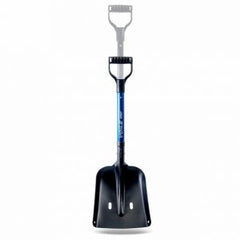Backcountry Skiing Checklist
 Everything you Need for Alpine Ski Touring
Everything you Need for Alpine Ski Touring
Backcountry skiing has become extremely popular in the past decade and continues to rapidly increase as more people discover the sport. Backcountry skiing is a generic term used for Alpine touring (AT) outside of ski resort boundaries. Backcountry skiing can also be combined with Sidecountry skiing, which is when you access the terrain through a lift before exiting the resort. It is important to have the proper equipment when you are skiing in the backcountry- for both safety and fun. Just getting started, or unsure of what you need for backcountry skiing? Check out our backcountry skiing checklist to learn about all of the backcountry skiing essentials.
-
 Shovel- Backcountry shovels aren’t just for building jumps! Carrying a shovel with you in the backcountry is essential for avalanche rescue safety. Avalanche shovels can also be used for snowpack and stability tests. Backcountry shovels can vary in design, but they are usually made out of aluminum, because of its lightweight yet durable characteristics. You can find shovels here in some of our online rescue sets.
Shovel- Backcountry shovels aren’t just for building jumps! Carrying a shovel with you in the backcountry is essential for avalanche rescue safety. Avalanche shovels can also be used for snowpack and stability tests. Backcountry shovels can vary in design, but they are usually made out of aluminum, because of its lightweight yet durable characteristics. You can find shovels here in some of our online rescue sets.
-
 Probe- An avalanche probe is a necessary safety tool for anyone looking to venture into the backcountry. A probe will help you locate an avalanche victim and determine the burial depth. Avalanche probes come in different lengths, but they all fold down to easily fit in a backpack.
Probe- An avalanche probe is a necessary safety tool for anyone looking to venture into the backcountry. A probe will help you locate an avalanche victim and determine the burial depth. Avalanche probes come in different lengths, but they all fold down to easily fit in a backpack.
-
 Skins- Touring skins are what allow you to effectively ascent the hill. They are usually made of nylon and/or mohair and help give you traction as you climb. AT skins with more mohair will glide better, but they do not have as much traction as synthetic materials. Typically, skins will have a combination of both for maximum versatility. Skins should be trimmed so that they match the silhouette of the skis. They have an adhesive base, which sticks to the ski and provides traction on the side.
Skins- Touring skins are what allow you to effectively ascent the hill. They are usually made of nylon and/or mohair and help give you traction as you climb. AT skins with more mohair will glide better, but they do not have as much traction as synthetic materials. Typically, skins will have a combination of both for maximum versatility. Skins should be trimmed so that they match the silhouette of the skis. They have an adhesive base, which sticks to the ski and provides traction on the side.
-
 Bindings- There are two types of Alpine Touring bindings- Frame and tech. Frame bindings are heavier, but they are compatible with traditional alpine boots in addition to most tech boots. Tech bindings, which are sometimes referred to as Dynafit bindings, extremely lightweight. A lightweight binding will make climbing uphill significantly easier. Tech bindings are only compatible with AT tech boots that have pin-style tech inserts. They are not recommended for resort skiing since they are more delicate.
Bindings- There are two types of Alpine Touring bindings- Frame and tech. Frame bindings are heavier, but they are compatible with traditional alpine boots in addition to most tech boots. Tech bindings, which are sometimes referred to as Dynafit bindings, extremely lightweight. A lightweight binding will make climbing uphill significantly easier. Tech bindings are only compatible with AT tech boots that have pin-style tech inserts. They are not recommended for resort skiing since they are more delicate.
-
 Boots- Alpine touring boots have a few unique features designed to increase ski climbing ability. Alpine Touring boots (AT) boots have a walk mode that unlocks the ski boot cuff for ascension, they can then lock into place for skiing downhill. Most AT boots also have ‘pinholes’ to attach to tech bindings. AT ski boots for backcountry touring typically are lighter weight and minimalist in design.
Boots- Alpine touring boots have a few unique features designed to increase ski climbing ability. Alpine Touring boots (AT) boots have a walk mode that unlocks the ski boot cuff for ascension, they can then lock into place for skiing downhill. Most AT boots also have ‘pinholes’ to attach to tech bindings. AT ski boots for backcountry touring typically are lighter weight and minimalist in design.
-
 Adjustable poles: Adjustable poles make it easier to adapt to varying terrain. If you are climbing uphill, you likely want shorter poles since they will be above you. However, on flatter terrain, it can be efficient to have longer poles. This way, they can work like hiking poles or cross country poles. They also can be collapsed down for easy traveling and convenience for varying terrain.
Adjustable poles: Adjustable poles make it easier to adapt to varying terrain. If you are climbing uphill, you likely want shorter poles since they will be above you. However, on flatter terrain, it can be efficient to have longer poles. This way, they can work like hiking poles or cross country poles. They also can be collapsed down for easy traveling and convenience for varying terrain.
-
 Backpack: While you may not need a backcountry specific backpack, you will want some form of a backpack to hold all of your equipment. Alpine touring backpacks usually have dedicated pockets for your avalanche safety equipment, straps for carrying skis, and are anatomically designed for dynamically climbing. It is common to see backcountry backpacks with hydration packs so that hikers can easily stay hydrated without digging through a full pack.
Backpack: While you may not need a backcountry specific backpack, you will want some form of a backpack to hold all of your equipment. Alpine touring backpacks usually have dedicated pockets for your avalanche safety equipment, straps for carrying skis, and are anatomically designed for dynamically climbing. It is common to see backcountry backpacks with hydration packs so that hikers can easily stay hydrated without digging through a full pack.
-
 Beacon- Beacons are extremely necessary for anyone who is skiing outside of resort bounds. They allow you to search for others after an avalanche, or for others to find you. It is important that you fully understand how to use your beacon before you venture out because you need to be able to act quickly. Avalanche beacons have varying ranges- the greater the range, the more likely someone else is to find you.
Beacon- Beacons are extremely necessary for anyone who is skiing outside of resort bounds. They allow you to search for others after an avalanche, or for others to find you. It is important that you fully understand how to use your beacon before you venture out because you need to be able to act quickly. Avalanche beacons have varying ranges- the greater the range, the more likely someone else is to find you.
-
 Skis: While any alpine ski can be used for backcountry skiing, athletes tend to opt for lightweight skis that won’t weigh them down as they ascend the mountain. Some backcountry specific skis will have designated slots for the alpine touring skins to clip into. It is usually best to aim for a ski between 95-110 mm underfoot for backcountry skiing. This will you give you width for the powder without too much weight.
Skis: While any alpine ski can be used for backcountry skiing, athletes tend to opt for lightweight skis that won’t weigh them down as they ascend the mountain. Some backcountry specific skis will have designated slots for the alpine touring skins to clip into. It is usually best to aim for a ski between 95-110 mm underfoot for backcountry skiing. This will you give you width for the powder without too much weight.
If you are interested in getting started with backcountry skiing, it is critical that you have proper avalanche safety training. Out of everything you need for backcountry skiing, education is the most important. In addition to our backcountry skiing checklist, Utah Ski Gear has a large array of Alpine Touring gear that is perfect for any backcountry or side country expedition.




 Everything you Need for Alpine Ski Touring
Everything you Need for Alpine Ski Touring










